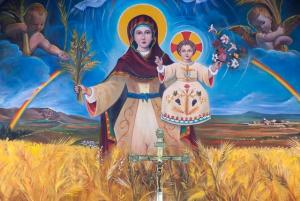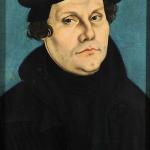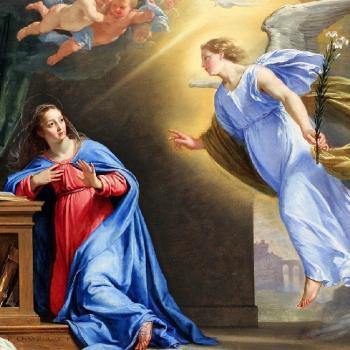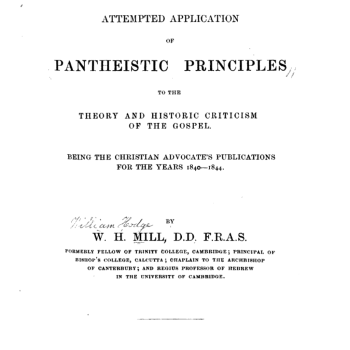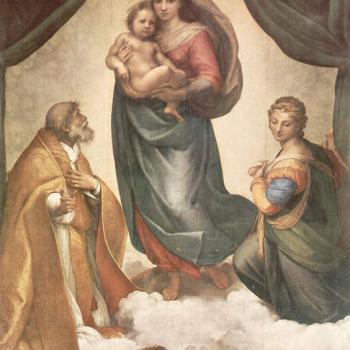Guest post by my friend Rosemarie Scott: wife, mother of three and homemaker, living in New York. She is the author of Clean of Heart (2-15) and the webmistress of The Mystical Rose Catholic Page.
*****
[Note: In late 2019, I wrote the article “Is ‘Mother Earth’ a Catholic Concept?” At the end, I stated my intention to write a follow-up article exploring “earthy” images of the Virgin Mary. Now, after a pandemic shutdown, the catastrophic failure of my computer (which obliterated my original notes for the article), two hospital stays and just a lot of “life” getting in the way, I have finally, by the grace of God, completed the promised second article. If you haven’t read the original article, please read it before this one, because it lays the necessary groundwork for understanding this article. Anyway, here is the promised follow-up. AMDG et BVMH]
Introduction
The previous article, Is “Mother Earth” a Catholic Concept?, shows that a truly Christian understanding of the earth-as-mother is possible, one which excludes pagan deification of the planet. “Our sister mother earth,” as Saint Francis of Assisi called her, is no goddess. In fact, since there is no such thing as a goddess, the term ”mother” never equals “goddess” in Catholicism. Mary our Mother is not a goddess. Holy Mother Church is not a goddess. Our human mothers are not goddesses. Likewise earth, the mother of all (Sirach / Ecclesiasticus 40:1) is not a goddess.
That article also discusses the patristic teaching that the primeval earth in the Book of Genesis is a type of Our Lady. Adam was formed from the earth’s matter (Latin materia, from mater = mother) analogous to the New Adam taking flesh from the Virgin Mary. The Church Fathers drew this parallel often: the first Adam was the son of the virgin earth, the Second Adam is the Son of the Virgin Mary.
Our Lady is, therefore, the anti-type of the virgin earth which “mothered” the first Adam. She is the blessed fulfillment of what the newly-created earth prefigured. Many Saints even interpreted Scriptural passages referring to the earth as mystically signifying Mary.
Regarding Psalm 67:7, “The earth has yielded her fruit,” Saint Jerome comments: “The earth is holy Mary who is from our earth, from our seed, from this clay, from this slime, from Adam. ‘Dust you are and unto dust you shall return.’ This earth has yielded its fruit; what it lost in the Garden of Eden, it has found in the Son.” (Homily 6 on the Psalms)
Regarding Psalm 85:11, “Truth is sprung out of the earth,” Saint Augustine of Hippo writes: “Whence did Mary spring? From Adam. Whence did Adam come? From the earth. If Mary sprang from Adam, and if Adam came from the earth, then Mary, too, came from the earth. If this is so, let us acknowledge the truth of the words: ‘Truth is sprung out of the earth’… since Christ was born of a virgin.” (Sermon 189 for the Feast of the Nativity, 2)
Even a verse like Revelation 18:1 signifies her, according to Saint Bonaventure:
For this Virgin was wonderfully illuminated by the presence of the Lord, according to that word of the Apocalypse: ‘I saw another angel coming down from heaven, having great power, and the earth was enlightened by the glory of him….’ The Son of God is the Angel of Great Counsel; the earth illuminated by the glory of Him is Mary, who, as she was illuminated by His grace in the world, is now illuminated by His glory in Heaven…. (Mirror of the Blessed Virgin Mary, Ch. III, emphasis mine)
Later in the same work, he applies more Bible passages to her:
…Let us consider that Mary is in very truth full of the riches of a good life. Of this plenitude we can truly say: ‘The earth is the Lord’s’ (Psalm 24:1). By the earth is signified Mary, of whom we read in Isaias: ‘Let the earth be opened, and bud forth a Savior!’ (Isaiah 45:8). What is more lowly than the earth? What more useful? We all tread the earth under our feet, and draw from it the nourishment of our life. Whence have we food and clothing, bread and wine, wool and thread, flax, and all the necessaries of life except from the earth, and from the fullness of the earth? What, therefore, is more lowly, what more useful than the earth? In like manner, what is more humble, what more useful than Mary? She by her humility is the very least of all; by her fullness of grace, the most useful of all. (Ibid., Ch. VII)
And Saint Thomas Aquinas writes regarding Ezekiel 43:2: “This indeed is signified: ‘Behold the glory of the God of Israel came in by the way of the east,’ i.e. by the Blessed Virgin, ‘and the earth,’ i.e. her flesh, ‘shone with His,’ i.e. Christ’s, ‘majesty.’” (Summa Theologica, III:27:3)
Because of this association of Mary with the earth, Saints throughout the centuries have used many “earthy” symbols for her. Among them are a garden paradise, a wheat field, and a mountain.
Mary as Garden
My sister, my spouse, is a garden enclosed, a garden enclosed, a fountain sealed up.
— Song of Songs 4:12
The bride in the Song of Songs is compared to an enclosed garden. Saints throughout the ages have seen in this bride a figure of both the Church and the Blessed Virgin. This led to them calling the latter an “enclosed garden” (hortus conclusus in Latin) and comparing her to a garden:
“The Virgin was truly a garden of delights; for he there planted every kind of flower, and all the sweet odors of virtues”. (St. Sophronius of Jerusalem, De Assumpt.)
Thou, O great Mother of God, art the enclosed garden, into which the hand of a sinner never entered to gather its flowers. Thou art the beautiful garden in which God has planted all the flowers that adorn the Church, and amongst others the violet of thy humility, the lily of thy purity, the rose of thy charity. With whom can we compare thee, O Mother of grace and beauty? Thou art the paradise of God, from thee issued forth the fountain of living water that irrigates the whole earth. (St. Bernard of Clairvaux, Depr. Ad. Gl. V., quoted in St. Alphonsus de Liguori, The Glories of Mary, p. 324)
Religious art expressed this by depicting Our Lady sitting in a garden surrounded by a wall (see an example).
The Saints linked this image with the Garden of Eden, which they also saw as a type of Mary:
O earth that, without seed, has brought forth the fruit of salvation! O Virgin that surpasses the very paradise of Eden! (St. Theodotus of Ancyra, Third Homily, n.1)
Today the Eden of the new Adam (heaven) receives the true Paradise (Mary), in which sin is remitted and the tree of life grows, and our nakedness is covered…. The serpent, by whose deceitful promise we were likened to brute beasts, did not enter into this Paradise. The only begotten Son of God, God himself, of the same substance as the Father, took His human nature of the pure Virgin. (St. John of Damascus, On the Dormition)
It is said in Genesis: the Lord God planted a paradise from the beginning, in which He planted man to dress and keep it (2,8.15). But he dressed and kept it badly. Thus it was necessary that the Lord God plant another and far better paradise, that of the blessed Mary, unto which the exiles of the first might return. In this paradise was placed the second Adam, who dressed and kept it…. He kept Her, preserving Her integrity; He dressed Her, making Her fecund; He kept Her, not violating Her virginity. Cursed in the work of Adam, the earth first produced thorns and thistles on being cultivated. Our earth, that is, the Blessed Virgin, without the labor of man, brought forth that blessed fruit, whom today She offered to the God and Father in the Temple. (St. Anthony of Padua, A Sermon on the Purification of our Lady, #1)
The place in which Mary conceived corporeally was her holy womb, to which may be applied the word of Genesis: “The river which came forth from the paradise of pleasure (Jesus Christ from the Virgin’s womb) was to water the garden” (Gen. II, 10.) The special paradise is Mary; the universal paradise is the Church. Happy is the watering of both these gardens by the mystic river from the womb of Mary, Jesus Christ, who has said: “I will water my garden of plants” (Ecclus. XXIV, 42.) (St. Bonaventure, Mirror BVM, Ch. XI)
“We must realize that the Blessed Virgin is the true earthly paradise of the new Adam and that the ancient paradise was only a symbol of her…. This most holy place consists of only virgin and immaculate soil from which the new Adam was formed with neither spot nor stain by the operation of the Holy Spirit who dwells there” (St. Louis Marie de Montfort, True Devotion to Mary, par. 261)
Saint John Eudes compared her Immaculate Heart to the Garden of Eden in his book, The Admirable Heart of Mary. It is too extensive to quote here, so if you wish, you can read his words elsewhere.
The hymn “Salve Mundi Domina,” from the Little Office of the Immaculate Conception, addresses Our Lady as follows:
Hail, garden of pleasure!
Celestial balm!
Cedar of chastity!
Martyrdom’s palm!Thou land set apart
From uses profane!
And free from the curse
Which in Adam began!
The pious practice of planting Mary Gardens is a beautiful reflection of this imagery. Popularized in the 1950s, it involves planting a flower garden around a statue of Our Lady, using especially blossoms associated with her, such as roses, lilies, iris and the like. There is something so fitting about this devotion; a horticultural shrine to the New Garden of Eden, surrounded by the beauty of our sister mother earth.
Learn more about Mary Gardens.
Mary as a Wheat Field
“Thy belly is like a heap of wheat, set about with lilies.”
— Song of Songs 7:2
In the Gospel of St. John, Our Lord compares Himself to a grain of wheat (John 12:24), and calls Himself the Bread of Life (6:35). If Christ is the Finest Wheat, threshed in His Passion to become our Eucharistic Bread, then His Mother is the hallowed Field from which that Wheat grew.
We find this image in Christian art and writings throughout the centuries. Saint Gregory Thaumaturgus called Our Lady “the soil that, all untilled, bears bounteous fruit” (First Homily on the Annunication to the Blessed Virgin Mary). Saint Romanos the Melodist greets her: “Hail, unseeded earth!” In his Kontakion on the Nativity of Christ, Romanos depicts Mary saying to her Divine Son: “Tell me, my Child, how were you sown, or how were you planted in me?” (par. 2).
At the Maronite Mass, as the gifts of bread and wine are being received on the altar, the chant portrays Christ Himself saying:
…pure word without flesh I was sent from the Father.
Mary’s womb received me like good earth a grain of wheat…
In the Kontakion for the 3rd Chant of the Akathist Hymn, our Eastern brethren sing:
The power of the Most High then overshadowed the Virgin for conception, and showed her fruitful womb as a sweet field to all who wish to reap salvation…. Hail, O Land yielding the untainted Fruit…. Hail, O Field bearing abundant compassion
On March 24, Forefeast of the Annunciation, they sing to the Mother of God at Matins:
O Pure One, unsown field, receive at the angel’s word the Word of heaven, Who springs forth from you like fruitful wheat, nourishing the ends of the earth with the grain of understanding.
Here are more quotes from the Saints to this effect:
Therefore, thou art blessed indeed, because the fruit of thy womb is blessed; as a field is blessed because the fruit of it is blessed. Mary is that blessed field of which it is said: “Behold the smell of my son is as the smell of a plentiful field, which the Lord hath blessed” (Gen. XXVII, 27). St. Jerome says: “Well is Mary called a full field, because she is said to be full of grace, from whose womb the Fruit of life came forth to all believers.” O field truly blessed above all fields because of its fruit! O Mother truly blessed above all mothers because of thy Son!” (St. Bonaventure, Mirror BVM Ch. XIV)
From what has been said, we can understand that passage of the sacred Canticle: Thy belly is like a heap of wheat, set about with lilies… which applies to Mary. And it is explained by St. Ambrose, who says: “That although in the most pure womb of Mary there was but one grain of corn, which was Jesus Christ, yet it is called a heap of wheat, because all the elect were virtually contained in it;” and as Mary was also to be their Mother, in bringing forth Jesus, he was truly and is called the first-born of many brethren”… (Ap. Novar. Umbra V. c. 63) (St. Alphonsus de Liguori, The Glories of Mary, p. 41.)
Mary Wearing an “Ear Dress”
Medieval artwork expressed this by depicting Our Lady wearing an “ear dress”: a dress covered with golden ears of wheat. This “represents the Blessed Virgin as fertile soil and untilled field of God called to bear fruit, symbol for her virginal motherhood of God’s Son. This image makes reference to the Eucharist: Mary can be seen as the tabernacle of God’s Eucharistic presence.” [source of quote]
Our Lady of the Fields
Medieval Christians, who had more of a connection to the land than many of us moderns do, interpreted such imagery to mean that the Virgin would pray for a bountiful yield of their crops. This led to the development of many agricultural Marian titles over time.
Maronite Catholics (who, as we saw above, compare Mary to “good earth” in their Sunday liturgy) celebrate three unique feast days related to the Holy Virgin and the harvest. They are Our Lady of the Seeds (January 15), Our Lady of the Harvest (May 15) and Our Lady of the Grapes (August 15). These Marian titles and their feasts are rooted in the rural traditions of the Maronites, who have long been farmers and shepherds. They reflect the Maronite people’s appreciation for the natural world, deep connection to the earth and their dependence on it for their livelihood.
Yet another similar image, this one from Eastern Orthodoxy, is the icon of the Theotokos – the Multiplier of Wheat. In 1890, during a famine in Russia, the Mother of God appeared to Elder Ambrose of Optina in a dream. Seated on a cloud above an abundant field of rye, she promised to plead with God on behalf of the starving populace. Ambrose described the vision to the nuns of Shamordino Convent, who wrote an icon according to how she appeared in the dream. The icon was distributed far and wide and the peasants that year had a better harvest. Eventually the famine ended, thanks to devotion to the Theotokos – the Multiplier of Wheat.
So not only have Christians, since patristic times, compared the Virgin Mother of God to untilled yet fertile earth, but they have also long believed that she provides them with the fruits of mother earth through her intercession.
Mary as a Mountain
Great is the Lord, and exceedingly to be praised in the city of our God, in his holy mountain. With the joy of the whole earth is Mount Sion founded, on the sides of the north, the city of the great king.
— Psalm 48:2-3
Many significant events in Sacred Scripture occurred on hills or mountains. Some examples are: the mountains of Ararat, Mount Moriah, Sinai, Nebo, Calvary, and Olivet. Two very important mountains in Scripture are particularly associated with Our Lady: Mount Zion and Mount Carmel.
Our Lady of Mount Zion
Originally the name of a Jebusite fortress conquered by King David (2 Samuel 5:7), “Mount Zion” was later applied to Mount Moriah after King Solomon built the First Temple there (Isaiah 60:14; 1 Maccabees 4:36-38). The term “Zion” eventually came to mean not just the Temple Mount, but the entire city of Jerusalem and the entire land and people of Israel, personified as the “Daughter of Zion.”
By the time of Christ, Mount Zion more commonly referred to the Western Hill of Jerusalem. This hill has great significance for Christians. It is believed to be the site of the Upper Room, where Jesus instituted the Eucharist at the Last Supper, and where the Holy Spirit descended upon Our Lady and Jesus’ disciples at Pentecost. This would make Mount Zion the birthplace of the Church.
According to one ancient tradition, when Saint John the Evangelist took Mary into his home, it was located on or near Mount Zion. This was where she then lived until her Dormition and possibly where she was entombed before her Assumption. (An alternate belief pinpoints the town of Ephesus as the site of her tomb).
In the early 5th century, a Byzantine basilica, Hagia Sion (“Holy Zion” in Greek), was built on Mount Zion. It was later demolished during an attack on Jerusalem in AD 614. In the 12th century, a monastic order built the Abbey of Our Lady of Mount Zion over the ruins (note the Marian title: Our Lady of Mount Zion). That, too, was later destroyed, but the Church of the Dormition was built there in the early 20th century, which still stands to this day.
The biblical term “Daughter of Zion” has become a title of Mary in Catholicism. As a Jewish woman, she personifies the entire people of Israel as “Bride of God.”
The salutation to Mary (Lk 1:28-32) is modeled closely on Zephaniah 3:14-17: Mary is the daughter Zion addressed there, summoned to ”rejoice”, informed that the Lord is coming to her. Her fear is removed, since the Lord is in her midst to save her.…. In the address of the angel, the underlying motif – the Lucan portrait of Mary – surfaces: she is in person the true Zion, toward whom hopes have yearned throughout all the devastations of history. She is the true Israel in whom Old and New Covenant, Israel and Church, are indivisibly one. (Joseph Cardinal Ratzinger — (later Pope Benedict XVI — , Daughter Zion, pp. 42-43)
Many Saints have also compared Mary to a mountain, applying Scriptural passages about the “mountain of God” — Mount Zion — to her. Saint John of Damascus called her “God’s mountain, rich mountain, the mountain in which God has been pleased to dwell” (Homily 1 on the Dormition, 12-13 – see Psalm 68:16-17 for the biblical reference). Saint Bonaventure writes:
Again, Mary is blessed not only because of the gifts of her heart and of her lips, but also because of the grace of her life and conversation. Of this blessedness can be understood what is said in Jeremias (31:23): “May the Lord bless thee, beauty of justice, holy mountain.” The holy mountain is Mary, who is fitly called a mountain because of the loftiness of her life and manners. This is the mountain of which we read in Daniel: “A stone was cut out without hands” (Dan. 2:45.) This was when Christ was born of Mary without male co-operation. The beauty of this mountain is the beauty of justice. (Mirror BVM, Ch. XIV)
And Saint Alphonsus de Liguori says:
Isaias signified the same thing, when he said that, in a time to come, a mountain of the house of the Lord (which was the Blessed Virgin) was to be prepared on the top of all other mountains; and that, in consequence, all nations would run to this mountain to receive the divine mercies. And in the last days the mountain of the house of the Lord shall be prepared on the top of mountains, and it shall be exalted above the hills, and all nations shall flow unto it (Isaias 2:2). St. Gregory, explaining this passage, says, “It is a mountain on the top of mountains; for the perfection of Mary is resplendent above that of all the saints” (The Glories of Mary, p. 378)
Our Lady of Mount Carmel
“ Your head crowns you like Carmel”
— Song of Songs 7:5
Sacred Scripture mentions Mount Carmel several times as a place of God’s power and majesty. There it was that the Prophet Elijah defeated four hundred and fifty priests of the false idol Baal, proving decisively that YHWH is the one true God (1 Kings 18:16-40). According to tradition, after that victory Elijah established a school of prophets on Mount Carmel. His successor, Elisha, made the rounds of such schools at Bethel, Carmel and Samaria (2 Kings 2:25).
The Carmelite Order traces its spiritual heritage to this tradition. Officially founded in the 12th century by a group of hermits living on Mount Carmel and seeking to follow in Elijah’s footsteps, they devoted their first chapel to Our Lady. To this day, the order is known for its particular devotion to the Mother of God.
Mount Carmel is located in the northern part of the Holy Land, not too far from Nazareth. Mary no doubt looked upon that prominent range many times during her life, and may have visited it long after her Assumption. According to Carmelite tradition, Our Lady appeared in the 13th century to an early prior of the order, Saint Simon Stock. She gave him a brown scapular as a symbol of the Carmelite’s devotion to her and pledged her spiritual protection to those who would wear it devoutly. The Brown Scapular remains a popular Marian sacramental among Catholics to this day, and one of Mary’s many beautiful titles is Our Lady of Mount Carmel.
Some think that the word “Carmel” may mean orchard, vineyard or garden. This ties in with images of Mary as an enclosed garden, a paradise sacred to Our Lord. As the beautiful Carmelite hymn, Flos Carmeli (“Flower of Carmel”), extolls her:
Flower of Carmel,
Tall vine blossom laden;
Splendour of heaven,
Childbearing yet maiden.
None equals thee….Strong stem of Jesse,
Who bore one bright flower,
Be ever near us
And guard us each hour,
who serve thee here.Purest of lilies,
That flowers among thorns,
Bring help to the true heart
That in weakness turns
and trusts in thee.
The Virgin of Urkupiña
When Catholic missionaries first brought the Gospel to the Andes in South America in the sixteenth century, they encountered the religious beliefs of the indigenous people there. One prominent deity in Andean cosmology was Pachamama, a goddess revered as the earth mother or nature deity. She was especially associated with hills or mounds of earth, which were considered her physical manifestations and therefore sacred places where the people brought offerings to her.
The missionaries taught the Andean people about Jesus and told them that Pachamama was no deity. They were advised to pray to Jesus’ Mother instead. Andean Catholics soon began producing artwork in which Mary was incorporated into a mountain, with just her head and arms showing.
Besides supplanting Pachamama, this is a striking artistic depiction of Mary the Holy Mountain of God, as Saints have long called her.
Here we see an example of inculturation: incorporating into our Catholic Faith some benign, pre-Christian elements of a culture that is being evangelized. As the Church baptizes people, she can also choose to “baptize,” so to speak, some of their customs. Not only does God not object to this, but in this case, He seems to have approved the inculturation by blessing the Andean Catholics with a Marian apparition.
One day in August, a poor shepherd girl named Maria was watching her sheep by Cota Hill, near the town of Quillacollo, Bolivia. Suddenly, Our Lady appeared to her in great beauty, holding the Child Jesus. She spoke to little Maria in her own native tongue (called Quechua) and even let her play with the Christ Child. The Virgin and Child appeared to the young shepherdess on many occasions after that, causing her to take longer than usual to bring the flock home every day. This seemed strange to her parents. When they asked Maria the reason for her tardiness, she told them about the beautiful Lady whom she called “la mamita” (the little mother).
The next time the Blessed Virgin appeared to Maria, the girl ran to get her parents and some other people from the town to come and see her. By the time they all arrived at Cota Hill, Our Lady had moved up to the summit. When Maria saw her there, she pointed to the top of the hill and shouted in Quechua: “Urqupiña!” which means “She is already in the hill!” Thus the apparition became known as the Virgin of Urkupiña, and to this day a great festival in Bolivia celebrates her under that title every August.
Now, Cota Hill, being a hill, had previously been a place where the people brought offerings to Pachamama. Our Lord apparently intended to supplant this pagan worship with proper honor for His Mother, the Holy Mountain of God. This reminds us of the Virgin’s earlier apparition in Mexico on the Hill of Tepeyac – previously a worship site for an Aztec mother goddess. Our Lady of Guadalupe asked that a Christian temple be built there in her honor, clearly intending to displace the non-existent goddess.
We may also recall how early Roman Christians built a church over the ruins of a pagan temple dedicated to a goddess, naming the church Santa Maria Sopra Minerva (Holy Mary above Minerva). This is not a continuation of pagan idolatry under Christian guise, as Fundamentalist Protestants may assert, but the displacement of idolatry by Christian devotion. Our Lord seems well-pleased to replace the non-existent goddesses of paganism, who cannot love, with His own dear Mother, whose Immaculate Heart overflows with maternal love toward us all.
So the missionaries in South America were correct in striving to replace Pachamama with our Blessed Lady. Though not a goddess herself, Mary fulfills perfectly in her spiritual Motherhood what both our inanimate planet and the false pagan goddesses never could.
Earth Assumed into Heaven
The Mother of God is human, and as such she is part of the earth, for our mortal bodies are made of earth (though our souls belong to the spiritual realm). She is “from our earth… from this clay, from this slime,” as Saint Jerome said. The Church bids us on Ash Wednesday to “Remember that you are dust….” Mary, too, when she walked this planet, was dust; and now that humble Dust of the earth is immortal and assumed into glory. Between the Risen Body of Our Lord and the glorified body of Our Lady, a portion of planet earth now exists in heaven.
Yet Mary’s motherly Heart keeps drawing her, as it were, back to earth to console her children and turn their hearts to her Son. On a hill in Mexico, another hill in Bolivia, amid trees in Wisconsin, in a grotto in France, over a holm oak in Portugal, in a garden in Belgium… how often she comes to us in a natural setting! When she isn’t appearing near her Eucharistic Son in a church, she tends to grace the beauty of nature with her holy presence.
And her earthly children, in turn, honor her through nature. They plant Mary Gardens, crown her with blossoms during the month of May, write her icons using natural mineral pigments from the earth, and build Lourdes grottos out of field stones. Through human hands, mother earth herself honors the Virgin Earth assumed into Heaven.
Concluding Thoughts
Yes, the comparison of Mary to planet earth is quite apt. As mother earth nourishes and sustains life, so our Blessed Mother provides us spiritual nourishment, comforting and supporting all who turn to her in time of need. As mother earth provides a home for the human race, shielding us from the harshness of outer space, so Mary is our spiritual protector, shielding us under her mantle from the dangers of sin and the devil.
As mother earth is fertile, producing life, so the New Eve is the Mother of the living, who gave birth to our Savior and to His Mystical Body, the Church, in Him. As mother earth is home to stunning natural landscapes, so our Heavenly Mother is radiant with God’s own beauty, a source of holy wonder and rapture to the angels and saints.
Finally, as the earth revolves around the sun, so Mary’s entire existence revolves around Jesus Christ, the Sun of Justice (Malachi 4:2). Apart from Him she would be nothing.
However, as the first article pointed out, mother earth and our Mother Mary differ in the ability to love their children. Planet earth has no mother’s heart, only an iron core. Mary’s most pure Heart, in contrast, is the Heart of a true mother. A Heart formed from the stuff of earth yet filled with love both human and divine, indwelt by the Holy Spirit. As she told us on the Hill of Tepeyac nearly five centuries ago:
I am your merciful Mother, the merciful Mother of all of you who live united in this land, and of all humankind, of all those who love me, of those who cry to me, of those who seek me, of those who have confidence in me….
Am I not here who am your Mother? Are you not under my shadow and protection? Am I not your fountain of life? Are you not in the folds of my mantle, in the crossing of my arms? Is there anything else that you need?
If earth was the mother of Adam — and all humanity in him — in the old order of creation, then the Mother of God far surpasses her as our loving Mother in the new economy of salvation. The exaltation of her earthly body into heaven foreshadows the Day when our sister mother earth herself, along with the rest of creation, will be delivered from the servitude of corruption into the liberty of the glory of the children of God (Romans 8:21).
Holy Mary,
Virgin Earth bringing forth the New Adam,
Enclosed Garden of heavenly delights,
Our Lady of the Fields,
Holy Mountain in which God is pleased to dwell,
Virgin of Urkupiña,
Humble Earth assumed into Heaven,
Pray for us!
***
Photo credit: Icon fresco Our Lady of the Seeds, from the Chaldean Catholic Monastery of Our Lady of the Seeds in Alqosh, Iraq. [Mesopotamia Heritage]
***
Summary: The notion of Our Mother Mary & “Mother Earth” has a rich Catholic pedigree. Rosemarie Scott offers a fascinating survey of this Marian devotion in its many forms.
***


